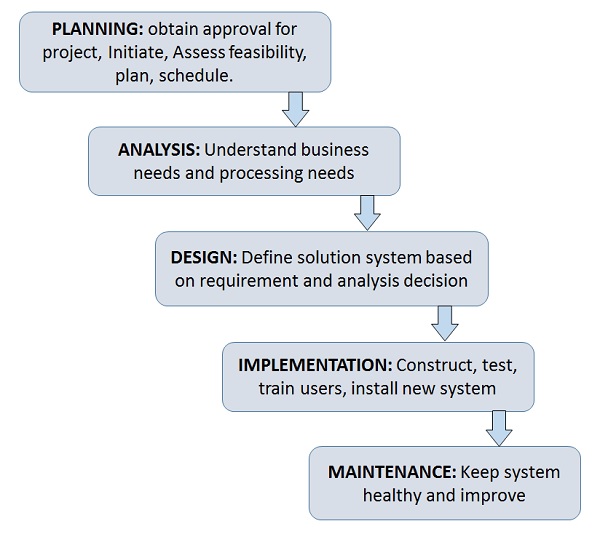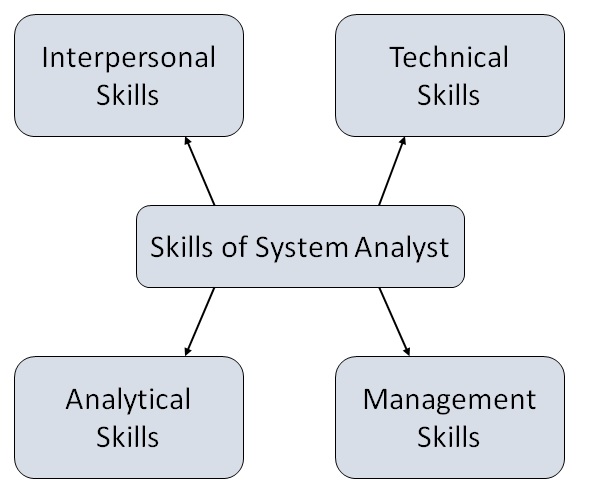An effective System Development Life Cycle (SDLC) should result in a
high quality system that meets customer expectations, reaches completion
within time and cost evaluations, and works effectively and efficiently
in the current and planned Information Technology infrastructure.
System Development Life Cycle (SDLC) is a conceptual model which includes policies and procedures for developing or altering systems throughout their life cycles.
SDLC is used by analysts to develop an information system. SDLC includes the following activities −


He pursues to match the objectives of information system with the organization goal.

System Development Life Cycle (SDLC) is a conceptual model which includes policies and procedures for developing or altering systems throughout their life cycles.
SDLC is used by analysts to develop an information system. SDLC includes the following activities −
- requirements
- design
- implementation
- testing
- deployment
- operations
- maintenance
Phases of SDLC
Systems Development Life Cycle is a systematic approach which explicitly breaks down the work into phases that are required to implement either new or modified Information System.
Feasibility Study or Planning
- Define the problem and scope of existing system.
- Overview the new system and determine its objectives.
- Confirm project feasibility and produce the project Schedule.
- During this phase, threats, constraints, integration and security of system are also considered.
- A feasibility report for the entire project is created at the end of this phase.
Analysis and Specification
- Gather, analyze, and validate the information.
- Define the requirements and prototypes for new system.
- Evaluate the alternatives and prioritize the requirements.
- Examine the information needs of end-user and enhances the system goal.
- A Software Requirement Specification (SRS) document, which specifies the software, hardware, functional, and network requirements of the system is prepared at the end of this phase.
System Design
- Includes the design of application, network, databases, user interfaces, and system interfaces.
- Transform the SRS document into logical structure, which contains detailed and complete set of specifications that can be implemented in a programming language.
- Create a contingency, training, maintenance, and operation plan.
- Review the proposed design. Ensure that the final design must meet the requirements stated in SRS document.
- Finally, prepare a design document which will be used during next phases.
Implementation
- Implement the design into source code through coding.
- Combine all the modules together into training environment that detects errors and defects.
- A test report which contains errors is prepared through test plan that includes test related tasks such as test case generation, testing criteria, and resource allocation for testing.
- Integrate the information system into its environment and install the new system.
Maintenance/Support
- Include all the activities such as phone support or physical on-site support for users that is required once the system is installing.
- Implement the changes that software might undergo over a period of time, or implement any new requirements after the software is deployed at the customer location.
- It also includes handling the residual errors and resolve any issues that may exist in the system even after the testing phase.
- Maintenance and support may be needed for a longer time for large systems and for a short time for smaller systems.
Life Cycle of System Analysis and Design
The following diagram shows the complete life cycle of the system during analysis and design phase.
Role of System Analyst
The system analyst is a person who is thoroughly aware of the system and guides the system development project by giving proper directions. He is an expert having technical and interpersonal skills to carry out development tasks required at each phase.He pursues to match the objectives of information system with the organization goal.
Main Roles
- Defining and understanding the requirement of user through various Fact finding techniques.
- Prioritizing the requirements by obtaining user consensus.
- Gathering the facts or information and acquires the opinions of users.
- Maintains analysis and evaluation to arrive at appropriate system which is more user friendly.
- Suggests many flexible alternative solutions, pick the best solution, and quantify cost and benefits.
- Draw certain specifications which are easily understood by users and programmer in precise and detailed form.
- Implemented the logical design of system which must be modular.
- Plan the periodicity for evaluation after it has been used for some time, and modify the system as needed.
Attributes of a Systems Analyst
The following figure shows the attributes a systems analyst should possess −
Interpersonal Skills
- Interface with users and programmer.
- Facilitate groups and lead smaller teams.
- Managing expectations.
- Good understanding, communication, selling and teaching abilities.
- Motivator having the confidence to solve queries.
Analytical Skills
- System study and organizational knowledge
- Problem identification, problem analysis, and problem solving
- Sound commonsense
- Ability to access trade-off
- Curiosity to learn about new organization
Management Skills
- Understand users jargon and practices.
- Resource & project management.
- Change & risk management.
- Understand the management functions thoroughly.
Technical Skills
- Knowledge of computers and software.
- Keep abreast of modern development.
- Know of system design tools.
- Breadth knowledge about new technologies.
No comments:
Post a Comment